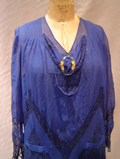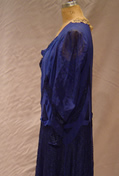This 1920s royal blue chiffon and lace evening gown was worn by suffragist Carrie Lane Chatman Catt (1859-1947). The gown, made from silk chiffon, has lace insets and handkerchief skirt panels over a crepe de Chine lining.
Background
This dress is from the collection of the National Nineteenth Amendment Society in Charles City, Iowa. The society is housed in the girlhood home of suffragist Carrie Lane Chatman Catt. Mrs. Catt owned this dress during the period of her life when she was traveling the world lecturing in support of universal suffrage and the League of Nations. The dress was in a trunk of clothing and other items of Carrie's that were given to her nephew, Clarence Lane, by his father (Carrie's older brother), Charles Lane, after Carrie’s death. It was passed down through the family, eventually coming to Carrie's great-great niece Ivadelle Lane Stevenson in Charles City, Iowa, who donated the trunk to the Society. From Mrs. Catt’s death in 1947 until its acquisition by Mrs. Stevenson, the trunk was stored in a garage in California. Since its donation in the 1990s, it has been stored in basements and attics in Iowa. After conservation, the original dress will be archivally boxed and stored in the Society’s archives, while the reproduction will be placed on display in the Society’s new museum in Mrs. Catt’s girlhood home, which is scheduled to open in May 2006.
Construction Notes
The dress is made of silk chiffon with lace insets and handkerchief skirt panels over a crepe de Chine lining. The chiffon bodice consists of three panels, a center back and two fronts, with an opening down center front. Both sides of the center front opening are bound with a fat 1/8" wide straight grain chiffon binding, and the opening has a separate 1 1/4" wide under lap placket. It closes with a hook and thread loop at the top and with 4 small snaps down the placket. The opening extends to approximately waist level.
The neckline is round at the back of the neck and forms a vee in the front. It is bound with a 1/8" wide band of bias chiffon. All of the binding was attached by machine then turned and finished with a hand slip-stitch. The neckline is decorated with a shaped piece of bound lace and chiffon threaded through a gold and rhinestone buckle tacked to the front of the dress. The original placement and arrangement of the buckle is unknown. The back of the neck is set off with a cream-colored lace collar.
The bodice panels are cut with straight grain on center front and center back with slight shaping at the side seams. The bust fullness is controlled with 9 hand stitched inverted tucks at the shoulders of the front panels. The side seams are stitched with a very small machine stitch. The seam allowance on the side seams was then turned under and stitched back with a running stitch by hand. The shoulder seams were stitched by machine then the seam allowances were turned in towards each other and hand stitched together to look like a French seam. The bodice is attached to the lining at the shoulder seams and armseyes.
| Shoulder Detail | Bodice Detail |
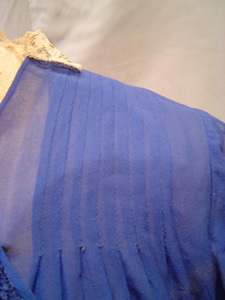 |
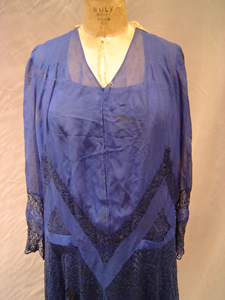 |
The chiffon bodice and lace handkerchief panels are separated by horizontal two zigzag bands; the top band is lace and the bottom band is chiffon. These inset bands are each approximately 2" wide and are 12" long from the highest to the lowest points. The low points are at center front and back and on the side seams. The high points are halfway between these points. The lace band is hand basted then machine topstitched to the chiffon bodice and the seam allowance on the bands is hand overcast. The chiffon band is machine topstitched to the lace band and the lace handkerchief panels, and the seam allowance is hand overcast. There is a 1" wide straight grain flat tube of the chiffon set at the mid-level of the chiffon band, running under the chiffon and over the lace. This band defines the 1920s dropped waist silhouette.
The skirt consists of four handkerchief panels falling from the high points of the bands. The panels are shaped so the hem is longer on the sides than at center front and center back, and there are two points on each panel, with the extra points falling near the side seams. The sides and hem of the panels has been bound with a 1/8" wide binding of bias chiffon attached by machine then finished by hand. The skirt panels have been slipstitched together for approximately 1" below the bands. There are also two sets of tacks holding the panels together every 6" down to the hem.
The armseyes of the dress are in the normal position and there is a one piece fitted chiffon sleeve. The sleeve is shaped with gathers at the elbow on the top side of the sleeve. It is set into the armseye by machine with very little ease. The cuff of the sleeve is trimmed with lace and chiffon zigzag bands like the dress with a point on the top of the arm. The low point of the sleeve bands is on the sleeve seam and fall 4 1/2" above the wrist. The high point is 8" above the wrist. Below the zigzag bands, the sleeve is lace. The hem is bound with a 1/8" wide binding of bias chiffon. There is a 2 1/2" long opening at the wrist on the underarm seam that closes with four 3/8" diameter chiffon covered buttons and hand knotted thread loops.
The yoke of the lining is made from blue crinkle chiffon down to the muscle point on the armseye. The vee of the neckline is deeper than the vee of the bodice so this layer is not seen. The neckline of this layer is hemstitched, worked in cream thread. I believe this was done with a special double needle finishing/picot machine. The crepe de Chine body of the lining is topstitched to the crinkle chiffon and the seam allowance is covered with lace seam binding. The lining is hand basted to the body of the dress at the back neckline, shoulder seams, and armseyes before the sleeves were set in.There are also the remains of lingerie loops: frayed ribbon and on one side, half a snap, at the shoulders.
The crepe de Chine lining is cut in four panels: center front and center back with two side front panels that end at the waist. The lining opens on the left side between the front and side front panel and closes with snaps. The placket is reinforced with hem tape. The side seams have been machine stitched, and there is evidence that the side seams in the torso area have been let out 1/2" on each side. The side front panels are topstitched to the front and back panels. There is a deep irregular inverted box pleat on the side seams of the lining below the dropped waistline. These pleats are controlled by hand. A pocket is hidden in the pleat on the right side, accessible between the tacks in the lace handkerchief panels. Behind the pleat on the left side is a store label that reads "O'Donovan ~ New York". The dropped waist circumference of the lining is 44" and the hem circumference is 66".
| Lining Detail |
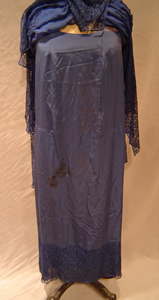 |
The hem of the crepe de Chine lining has a 3" wide straight grain band of the dress chiffon with a machine picot hem topstitched to the bottom of it. 5" above where the chiffon is attached, there is an 8" wide band of the dress lace topstitched on, also with a machine picot hem. The lace hem is at the same level as the bottom of the handkerchief points on the overdress. From the irregularity of the pleats and pieces of the side front panels, evidence of the removal of darts in the front below the side front panels, and the coloration of the label indicating dyeing, I believe this lining has been reworked.
Damage
Overall, this dress is in very good condition for its age and the conditions in which it has been stored. There is little disintegration in the fabric, all of the stitching is secure, and all of the closures are extant except the snaps on the lingerie loops.
There are a few small pinholes in the silk chiffon and a few small tears in the lace. There are also some fairly significant tears in the lace on the sleeve plackets. There are fractures and some rotting in the crepe de Chine of the lining. The crinkle chiffon on the top of the lining is also starting to fray apart where it is stitched to the crepe de Chine.
There are two large stains on the front of the dress, one on the chiffon just to the left of the placket at waist level and one on the right front handkerchief panel in the lap area. Both of these stains have corresponding stains on the crepe de Chine. There are large sweat stains under the arms. The sweat stains were intensified when the dress was worn in a fashion show since its donation to the Society. The fabric of the lining is starting to rot and disintegrate in these sweat stains.
The front neck drape has been moved, as evidenced by the remaining tacks higher on the neckline. The buckle on the front of the dress is also rather haphazardly attached with tacking and safety pins, and the drape does not currently hang gracefully. Since the tacking thread on the drape in no way matches the dress, I surmise that the drape was arranged and tacked on for one of the Society’s fashion shows. The lace collar on the back of the neck is also coming unstitched from the neckline. The lace collar and the buckle will be removed and put on the reproduction dress (for display in Carrie Lane Chatman Catt's childhood home which is also the location of the National Nineteenth Amendment Society in Charles City, Iowa).
© Jennifer Jacob, 2006


